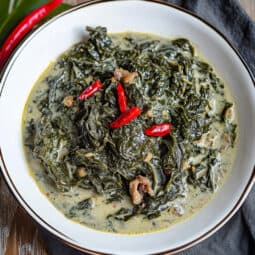
Authentic Bicolano Laing (Gabi Leaves in Coconut Milk)
Laing (pronounced "lah-ing") is a treasured dish from the Bicol Region, where coconut trees flourish and spicy cuisine reigns supreme. Originally known as "pinangat na gabi" in Bicol, this dish showcases the region's mastery of combining taro leaves with coconut milk and chilies. The dish reflects the abundance of taro plants in the region and the Bicolano's expertise in creating rich, spicy coconut-based dishes.IMPORTANT SAFETY NOTE: NEVER use fresh taro leaves. They are toxic when raw. ONLY use properly dried taro leaves from reliable sources. If leaves cause any irritation, discontinue use immediately. When in doubt, purchase pre-prepared dried taro leaves.
Ingredients
Main Ingredients
- 2 ounces dried gabi (taro leaves) you must never use fresh taro leaves, as they contain calcium oxalate crystals that can cause severe irritation
- 1 pound pork belly diced
- 4 cups coconut milk
- 1 cup coconut cream
- 8 Thai chili peppers might be too intense for non-Bicolano palates
Aromatics
- 2 lemongrass stalks
- 1 onion peeled and chopped
- 4 cloves garlic peeled and minced
- 1 thumb-size ginger peeled and minced
- 1 tablespoon shrimp paste
- Salt and pepper to taste
- 1 tablespoon canola oil
Instructions
- First, inspect your dried taro leaves (tuyong dahon ng gabi) carefully. They should be brittle to the touch and free from any discoloration or mold. Break them into smaller, manageable pieces and set aside. If the pieces are too large (malalaki), you can gently crumble them using clean, dry hands (malinis at tuyong kamay).
- Heat canola oil in a large, heavy-bottomed pot (makapal na kaldero) over medium heat (katamtamang init). Once hot, add your minced garlic (bawang), chopped onions (sibuyas), and ginger (luya). Sauté until the onions become translucent and the garlic turns slightly golden (hanggang maging malinaw ang sibuyas at mag-golden brown ang bawang), about 3-4 minutes.
- Add the diced pork belly (liempo) to the pot. Cook until the pork starts to brown lightly, about 5-7 minutes. Add the shrimp paste (bagoong alamang) and stir well to combine with the meat and aromatics.
- Pour in the coconut milk (gata) but leave the coconut cream (kakang gata) for later. Add the bruised lemongrass stalks (tanglad) and Thai chili peppers (siling labuyo). Bring to a very gentle simmer (pakuluan ng dahan-dahan) - you should only see small bubbles forming.
- Now comes an important step: add your dried taro leaves but DO NOT STIR (huwag haluin) for the first 10 minutes. Let them naturally sink into the coconut milk. Cover the pot and maintain a gentle simmer at low-medium heat (mahina hanggang katamtamang init).
- After 10 minutes, you can now gently push down any floating leaves with a wooden spoon. Still avoid stirring vigorously. Continue cooking for about 25 minutes more, or until the leaves have significantly darkened and softened.
- Add the coconut cream (kakang gata) and continue simmering. The key here is patience - cook until you see the orange-red oil starting to separate and float to the surface (hanggang lumitaw ang pulang langis sa ibabaw). This usually takes about 20-25 minutes more. This orange-red oil (pulang langis) is your sign of a properly cooked laing.
- Season with salt and pepper to taste (timplahan ng asin at paminta). If you want it spicier, you can add more chilies at this point. The final consistency should be creamy but not soupy (malapot pero hindi masabaw) - the sauce should coat the back of your spoon.
- Let it rest for 5-10 minutes before serving. This allows the flavors to settle and the sauce to thicken slightly more. Serve hot with freshly steamed rice (mainit na kanin).
Your laing is ready when:
- The pork is fork-tender (malambot ang karne)
- The sauce is thick and creamy (malapot)
- Orange-red oil has surfaced (may pulang mantika sa ibabaw)
- The leaves are very tender and dark (malambot at maitim ang dahon)
- No more raw coconut milk smell remains (wala nang amoy ng hilaw na gata)
Tips from Lola's Kitchen
- Always use dried taro leaves - fresh ones can cause intense itching
- The best laing has visible orange oil on top
- Never boil the coconut milk vigorously to prevent curdling
- Choose darker dried taro leaves for better flavor
- When reheating, add a splash of coconut milk if needed
Nutrition
Calories: 1291kcalCarbohydrates: 14gProtein: 21gFat: 133gSaturated Fat: 83gPolyunsaturated Fat: 8gMonounsaturated Fat: 33gTrans Fat: 0.01gCholesterol: 124mgSodium: 202mgPotassium: 975mgFiber: 2gSugar: 2gVitamin A: 83IUVitamin C: 22mgCalcium: 81mgIron: 10mg
Tried this recipe?Let us know how it was!